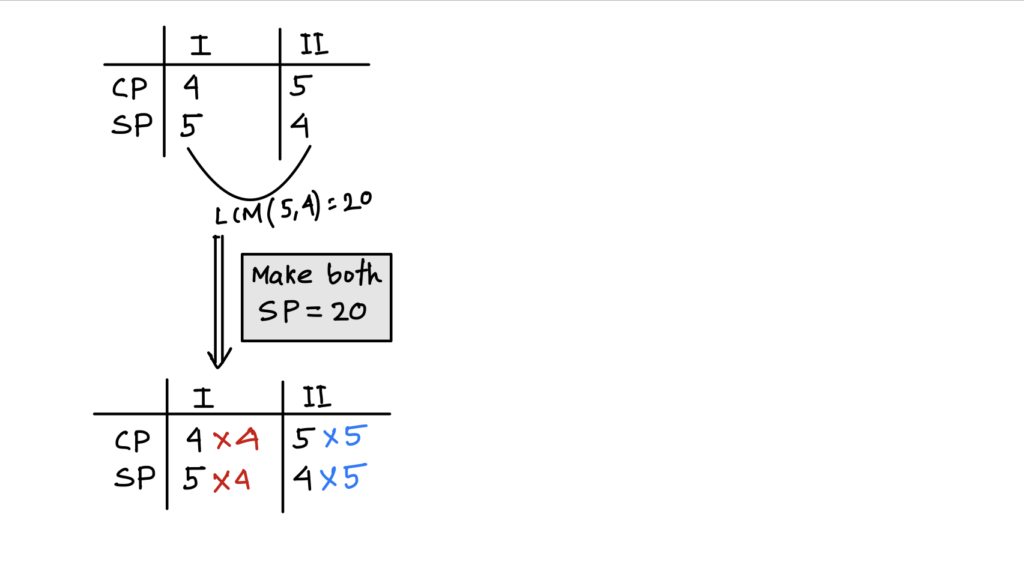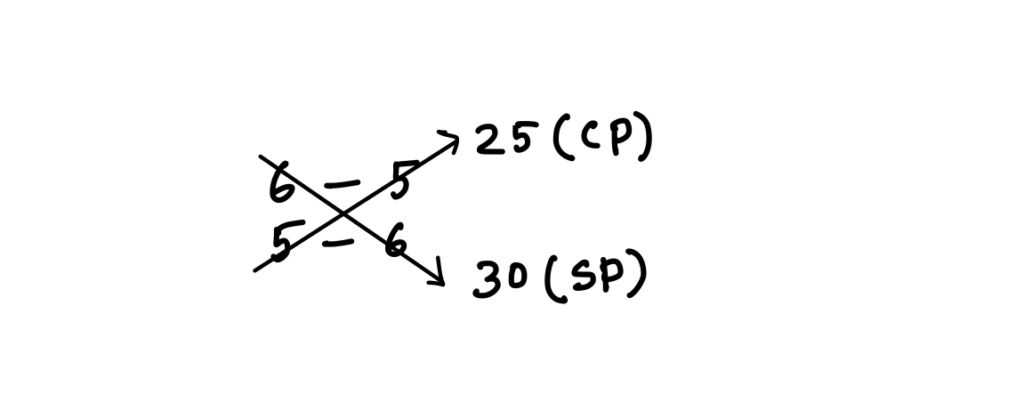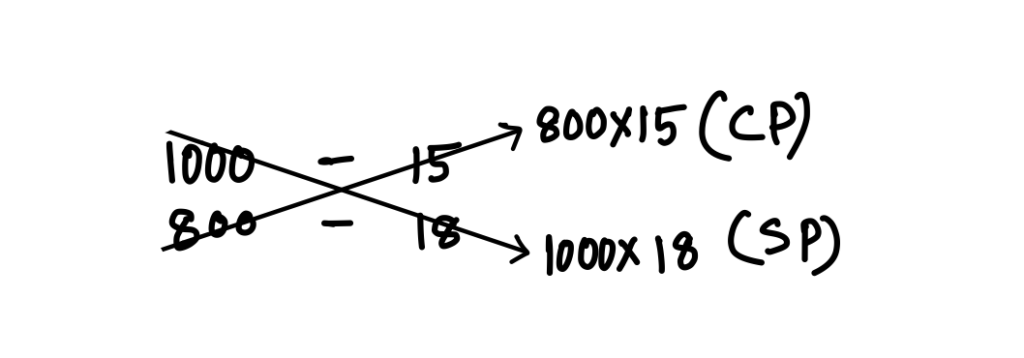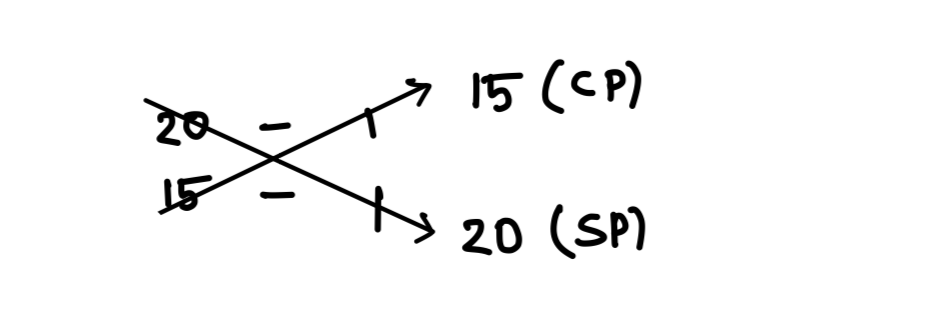Basic terms and concepts
CP = cost price, the price at which things are bought
SP = selling price, the price at which things are sold at a certain profit or loss
P = profit, profit occurs when SP > CP and it equals to (SP – CP). Profit is also called gain.
L = loss, loss occurs when SP < CP and it equals to (CP – SP)
∴ SP = CP + P = CP – L
Now, some mathematical part
\begin{align*} \text{P}\% &=\displaystyle \frac{\text{P}}{\text{CP}}\times 100\\ \text{L}\% &=\displaystyle \frac{\text{L}}{\text{CP}}\times 100 \end{align*}Unless specified CP is the basis of profit or loss percentage
If there is a profit or loss of x%
SP = CP(100±x)%
⇒ CP = \displaystyle\frac{\text{SP}}{(100\pm \text{x})\%}
Some other very important math tricks we have already discussed will be used here.
- Most Important Maths Tricks for Any Exam – Total=100%
- Most Important Maths Tricks for Any Exam – Line Method
- Most Important Maths Tricks for Any Exam – AB Method
Question: A man sells an article at Rs. 230 and gains 15%. Find its cost price?
CP = \displaystyle\frac{\text{SP}}{115\% } = \displaystyle\frac{230}{115} \times 100 = 200
Aliter:
If you have read our article on Basis = 100% you know that CP = 100%
115% = 230
100% = 200
Same CP
Question: A man buys two articles for Rs. 200 each. He sells the first a profit of 12% and second at profit of 6%, find his net profit%?
Ans: 9%
Explanation:
Profit on 1st article = 200 \times \displaystyle\frac{12}{100} = 24
Profit on 2nd article = 200 \times \displaystyle\frac{6}{100} = 12
Total profit = 24 + 12 = 36
Total CP = 200 +200 = 400
So, net profit = \displaystyle\frac{36}{400} × 100 = 9%
Aliter:
Net profit = \displaystyle\frac{12+6}{2}% = 9%
| Net profit is just numerical average of all profit or loss percentage |
| Proof: Let two articles are of each cost price = CP and have profit x\% and y\% Total cost price = 2CP Total profit = CP\times \displaystyle\frac{x}{100} +CP\times \displaystyle\frac{y}{100} \qquad\qquad= CP\times\displaystyle \frac{x+y}{100} Net profit% = \displaystyle\frac{\text{Total profit}}{\text{Total }CP} \qquad\qquad\quad= \displaystyle\frac{CP\left(\displaystyle\frac{x+y}{100}\right)}{2CP} \qquad\qquad\quad= \displaystyle\frac{x+y}{2} If no of article are three (third articles has profit of z\% Total cost price = 3CP Total profit = CP\left(\displaystyle\frac{x+y+z}{3}\right) Net profit% = \displaystyle\frac{\text{Total profit}}{\text{Total }CP} \qquad\qquad\quad= \displaystyle\frac{CP\left(\displaystyle\frac{x+y+z}{100}\right)}{3CP} \qquad\qquad\quad= \displaystyle\frac{x+y+z}{3} So net profit is the average of given profits. If it is loss use negative sign before the value. |
Question: A man buys three articles for Rs. 780 each. He sells the first at a profit of 30%, second one at a profit of 20% but gets only 10% as whole. Find his profit or loss percentage in the third article?
Ans: 20%
Explanation:
\displaystyle\frac{30+20+x}{3} = 10
⇒ x = -20
So, loss on third article and loss is 20%.
More problems on Same CP
Same SP
Question: Two articles are sold at the same price. One at a profit of 75% and another at a loss of 30%. What is the overall profit or loss?
Ans: No profit, no loss
Explanation:
Method 1: Basic method taking any SP (generally 100)
This method is best if you have access to calculator
SP of each article = 100
Total SP = 200
Total CP = \displaystyle\frac{100}{1.75}+ \displaystyle\frac{100}{0.7} = 200
Method 2: Basic approach using LCM
SP is 175% of CP and 70% of CP
Now, LCM(175, 70) = 350
Let, SP of each article = 350
Total SP = 700
CP1 = \displaystyle\frac{350}{175}\times 100 = 200
CP2 = \displaystyle\frac{350}{70}\times 100 = 500
Total CP = 200 + 500 = 700
So, no loss, no profit.
Method 3: Using fraction of P% or L%
No need to bother about SP in this method
75% profit = \displaystyle\frac{3}{4} ⇒ profit of 3 on 4
30% loss = \displaystyle\frac{3}{10} ⇒ loss of 3 on 10

See here already selling prices are same. If it was not same, we would have to take LCM of the SPs and make corresponding changes to make it same. (See the next question for clarity)
Method 4: using shortcut formula
Note: The following formula can only be used for two articles whereas all the previous methods are applicable to any number of articles
If x\% and y\% are two interest rates,
| Net profit/loss = \displaystyle\frac{100(x+y)+2xy}{200+(x+y)} |
Suppose y = -x (i.e, profit% = loss%)
Net profit/loss = -\displaystyle\frac{x^2}{100}
In this case there will always be a loss of \left(\displaystyle\frac{x}{10}\right)^2
For this problem x = 75, y = -30
So net profit/loss = \displaystyle\frac{100(75-30)+2\times 75\times -30}{200+75-30}
\qquad\qquad\qquad = \displaystyle\frac{100\times 45-45000}{275}
\qquad\qquad\qquad = 0
So, no profit or no loss
Question: Selling prices for two articles are same (i.e., 25 lakhs). First article was sold at profit of 25% and another sold at 20% loss. Find out overall profit/loss%?
Ans: 2 \displaystyle\frac{18}{41}\% loss
Explanation:
If you can remember the shortcut formula it’s the easiest way to get the answer.
x = 25, y = – 20
Net profit/loss = \displaystyle\frac{100(25-20)+2\times 25\times -20}{200+25-20}
\qquad\qquad\qquad= \displaystyle\frac{500-1000}{205}
\qquad\qquad\qquad= -\displaystyle\frac{500}{205}
\qquad\qquad\qquad= -2 \displaystyle\frac{18}{41}
So overall loss of 2 \displaystyle\frac{18}{41}\%
If you have a calculator
SP = 50
CP = \displaystyle\frac{25}{1.25} + \displaystyle\frac{25}{1.25} = 51.25
L% = \displaystyle\frac{1.25}{50}\times 100 = 2.44%
By using fraction of P% or L%
25% profit = \displaystyle\frac{1}{4} ⇒ profit of 1 on 4
20% loss = \displaystyle\frac{1}{5} ⇒ loss of 1 on 5

Total CP = 4×4 + 5×5 = 16 + 25 = 41
Total SP = 5 × 4 + 4 × 5 = 20 + 20 = 40
L% = \displaystyle\frac{1}{41}\times 100 = 2\displaystyle\frac{18}{41}\%
Question: A man sells two articles for Rs. 990 each. He gains 10% on first article and losses 10% on the second article. Find his net gain/loss%?
Using shortcut,
Net loss = \left(\displaystyle\frac{10}{10}\right)^{2} = 1\%
Question: The selling price of two articles are same. One is sold for 25% profit and another in 25% loss. What is the effective profit of loss percentage?
Using shortcut,
Loss = \left(\displaystyle\frac{25}{10}\right)^{2} = 6.25\%
Question: Three articles were sold for Rs. 1500 each. The seller gained profit of 20% and 25% on first two articles but loss of 20% on third article. What was the overall profit or loss%?
Ans: 4.04% profit
Explanation:
If you have access to calculator
SP = 1500 × 3 = 4500
CP = 1500(1.2-1 + 1.25-1 + 0.8-1) = 4325
P% = \displaystyle\frac{175}{4325}\times 100 = 4.04\%
Aliter:
SP = 1500 × 3 = 4500
CP1 = \displaystyle\frac{1500}{120}\times 100 = 1250
CP2 = \displaystyle\frac{1500}{125}\times 100 = 1200
CP3 = \displaystyle\frac{1500}{80}\times 100 = 1875
CP = 1250 + 1200 + 1875 = 4325
P% = \displaystyle\frac{175}{4325}\times 100 = 4.04\%
Similar Problem: Three articles were sold for Rs. 1500 each. The seller gained profit of 20% on first two articles each but loss of 20% on third article. What was the overall profit or loss%? [Ans: 2.857% profit]
Question: A man sold three articles for ₹550, ₹600 and ₹700 at a profit of 10%, 20% and -30% respectively. Find the overall profit/loss%.
Ans: 7.5% profit
Explanation:
SP = 550 + 600 + 700 = 1850
CP = \displaystyle\frac{550}{1.1} + \displaystyle\frac{600}{1.2} + \displaystyle\frac{700}{0.7} = 2000
L% = \displaystyle\frac{150}{2000}\times 100 = 7.5\%
More problems on Same SP
Part Selling
Question: A shopkeeper buys 5 quintals of sugar at Rs 30/kg. He sells \displaystyle\frac{1}{3} of it at a profit of 30% and remaining at a profit of 9%. Find his net profit.
Ans: 16%
Explanation:
Method 1: Basic Method
Total CP = (5 × 100) × 30 = 15000
Total Profit = \displaystyle\frac{1}{3} \times 15000 \times \displaystyle\frac{30}{100} + \displaystyle\frac{2}{3}\times 15000\times \displaystyle\frac{9}{100} = 2400
Hence P% = \displaystyle\frac{2400}{15000}\times 100 = 16\%
But we could solve it in lesser time following the 2nd method
Method 2: Shortcut
| Overall profit = \sum (\text{fraction}\times \text{P\% or L\%}) |
Net profit = \displaystyle\frac{1}{3}\times 30 + \displaystyle\frac{2}{3}\times 9 = 16\%
Question: Some articles are purchased for Rs. 3600. One third of them are sold at a profit of 10%. At what profit percentage should the remaining articles be sold to obtain a profit of 15% on the whole transaction?
Ans: 17.5%
Explanation:
\displaystyle\frac{1}{3}\times 10 + \displaystyle\frac{2}{3}\times x = 15⇒ 10 + 2x = 45
⇒ x = 17.5
More problems on Part Selling
#Quantity – Price
Question: A man buys guavas at 6 for Rs. 5 and sells all the guavas at 5 for Rs. 6. Find his net profit/loss%.
Ans: 44% profit
Explanation:
Method 1: (Basic method) using CP and SP of 1 piece
For 1 piece, CP = \displaystyle\frac{5}{6} and SP =\displaystyle\frac{6}{5}
SP > CP
P% = \displaystyle\frac{\text{SP}-\text{CP}}{\text{CP}}\times 100
\quad = \displaystyle\frac{\displaystyle\frac{6}{5}-\displaystyle\frac{5}{6}}{\displaystyle\frac{5}{6}}\times 100
\quad = \displaystyle\frac{36-25}{30}\times \frac{6}{5}\times 100
\quad = \displaystyle\frac{11}{25}\times 100
\quad = 44%
Method 2: #Quantity – Price
- We would write the given data in two rows as no of quantity – price. One for CP and another for SP.
- Cross multiply the numbers
- Take CP row data as CP and SP row data as SP
- Calculate P/L% on basis of CP, SP we’ve just got
Must remember that given data will be written as quantity first, followed by price for that quantity, other wise result will be wrong.

P% = \displaystyle\frac{11}{25}\times 100 = 44%
Note: By using 2nd method we could avoid fraction, and this can lead faster calculation, I hope.
Question: A man buys guavas at 3 for Rs. 10 and sells all the guavas at 4 for Rs. 15. Find his net profit or loss%.
Ans: 12.5%
Explanation:

P% = \displaystyle\frac{5}{40}\times 100 = 12.5%
Question: A dishonest dealer professes to sell his goods at a loss of 10% but uses a weight of 800gm instead of 1 kg. Find his profit or loss%.
Ans: 12.5% profit
Explanation:
Let, CP = ₹ 100 for 1000g
\therefore SP = ₹ 90 for 800g

Profit% = \displaystyle\frac{10000}{80000}\times 100 = 12.5%
If cross multiplication involves bigger numbers, we would use ratio of CP to SP instead of multiplying

\displaystyle\frac{\text{CP}}{\text{SP}} = \displaystyle\frac{800\times 100}{1000\times 90} = \displaystyle\frac{8}{9}
P% = \displaystyle\frac{1}{8}\times 100 = 12.5%
Question: A dishonest shopkeeper sells sugar at Rs. 18/kg which he has bought at Rs. 15/kg and he is giving 800 gm instead of 1000 gm. Find his actual profit percentage.

\displaystyle\frac{\text{CP}}{\text{SP}} = \displaystyle\frac{800\times 15}{1000\times 18} = \displaystyle\frac{2}{3}
P% = \displaystyle\frac{1}{2}\times 100 = 50%
More problems on #Quantity – Price
CP of a article = SP of b article type
Question: Cost price of 20 articles is same as selling price of 15 articles. Find the profit or loss%?
Ans: 33.33%
Explanation:
Method 1: Using ratio of cost price and selling price
20CP = 15SP
⇒ \displaystyle\frac{\text{CP}}{\text{SP}} = \displaystyle\frac{15}{20}= \displaystyle\frac{3}{4}
Profit of 1 on cost price 3
P% = \displaystyle\frac{1}{3}\times 100 = 33.33\%
Method 2: #Quantity – Price
Consider Price part 1 for both CP and SP

P% = \displaystyle\frac{5}{15}\times 100 = 33.33\%
Method 3: Corollary from Method 2
CP of a articles become SP and
SP of b articles become CP
For this problem,
SP = 20 and CP = 15
So, P% = \displaystyle\frac{5}{15}\times 100 = 33.33\%
Question: If the cost price of 15 articles be equal to the selling price of 20 articles, then find the loss% in the transaction.
Ans: 25% loss
Explanation:
SP = 15 and CP = 20
L% = \displaystyle\frac{5}{20}\times 100 = 25\%
Question: By selling 20 articles a shopkeeper makes a profit of SP of 2 articles. Find his profit percentage?
Ans: 11.11%
Explanation:
P = 2SP
Using Formula, SP = CP + P
For this problem,
20SP = 20CP + 2SP
⇒ 18SP = 20CP
⇒ \displaystyle\frac{\text{SP}}{\text{CP}} = \displaystyle\frac{20}{18} = \displaystyle\frac{10}{9}
P% = \displaystyle\frac{1}{9}\times 100 = 11.11\%
Question: Find profit or loss percentage
(i) While selling 5 pen a person gains profit equals to SP of 2 pens.
SP = CP + P
5SP = 5CP + 2SP
⇒ 3SP = 5CP
⇒ \displaystyle\frac{\text{SP}}{\text{CP}} = \displaystyle\frac{5}{3}
P% = \displaystyle\frac{2}{3}\times 100 = 66.67\%
(ii) While selling 5 pens a person loss equals to SP of 2 pens.
SP = CP – L
5SP = 5CP – 2SP
⇒ 7SP = 5CP
⇒ \displaystyle\frac{\text{SP}}{\text{CP}} = \displaystyle\frac{5}{7}
L% = \displaystyle\frac{2}{7}\times 100 = 28.57\%
(iii) While selling 5 pen a person gains profit equals to CP of 2 pens.
SP = CP + P
5SP = 5CP + 2CP
⇒ 5SP = 7CP
⇒ \displaystyle\frac{\text{SP}}{\text{CP}} = \displaystyle\frac{7}{5}
P% = \displaystyle\frac{2}{5}\times 100 = 40\%
(iv) While selling 5 pen a person loss equals to CP of 2 pens.
SP = CP – L
5SP = 5CP – 2CP
⇒ 5SP = 3CP
⇒ \displaystyle\frac{\text{SP}}{\text{CP}} = \displaystyle\frac{3}{5}
L% = \displaystyle\frac{2}{5}\times 100 = 40\%
More problems on CP of a article = SP of b article type
Discount
- Discount: Discount is the amount of rebate given on marked price (MP) of an article to attract customer or to increase selling.
- Marked price: The price on the label on an article/product is called marked price. It is also called list price. Prices are marked at certain percentage above cost price (CP).
Some formula regarding Discount
- Discount = MP – SP
- Discount% =
- For single equivalent discount we would use ab method
Question: A man marks his goods 40% above the CP and gives a discount of 10%. What percent profit does he make?
Ans: 26%
Explanation:

Profit = 26%
Aliter:
Apply ab method to Marked price percentage and discount percentage
(40, -10) → 40 – 10 + \displaystyle \frac{40\times -10}{100} = 30 – 4 = 26
Question: What percent above should a dealer marks his goods so that after giving a discount of 20%, he will get 20%?
Ans: 50%
Explanation:
(x, -20) → 20
⇒ x – 20 – \displaystyle\frac{20x}{100} = 20
⇒ x – \displaystyle\frac{x}{5} = 40
⇒ 4x = 200
⇒ x = 50
Aliter:
Let, CP = 100
So, SP = 120
Discount is given on MP and in this problem, discount is 20%
So, 80% of MP = 120
∴ MP = 120 × \displaystyle\frac{100}{80}= 150
The marked price is 50% above the CP.
Dishonest Dealers and Faulty Weights
We have a dedicated post on this topic. Kindly visit Dishonest Dealers and Faulty Weights for concepts and practicing problems on this topic.

Pingback: Profit and Loss - Practice Problems and Solutions
Pingback: Profit and Loss: Dishonest Dealers and Faulty Weights
I enjoy you because of all of the labor on this web page. Ellie enjoys participating in investigation and it is easy to understand why. Most people hear all of the lively medium you create useful guidance through your web blog and in addition inspire contribution from website visitors on this area then our favorite child is always becoming educated a great deal. Take advantage of the rest of the new year. Your conducting a superb job.